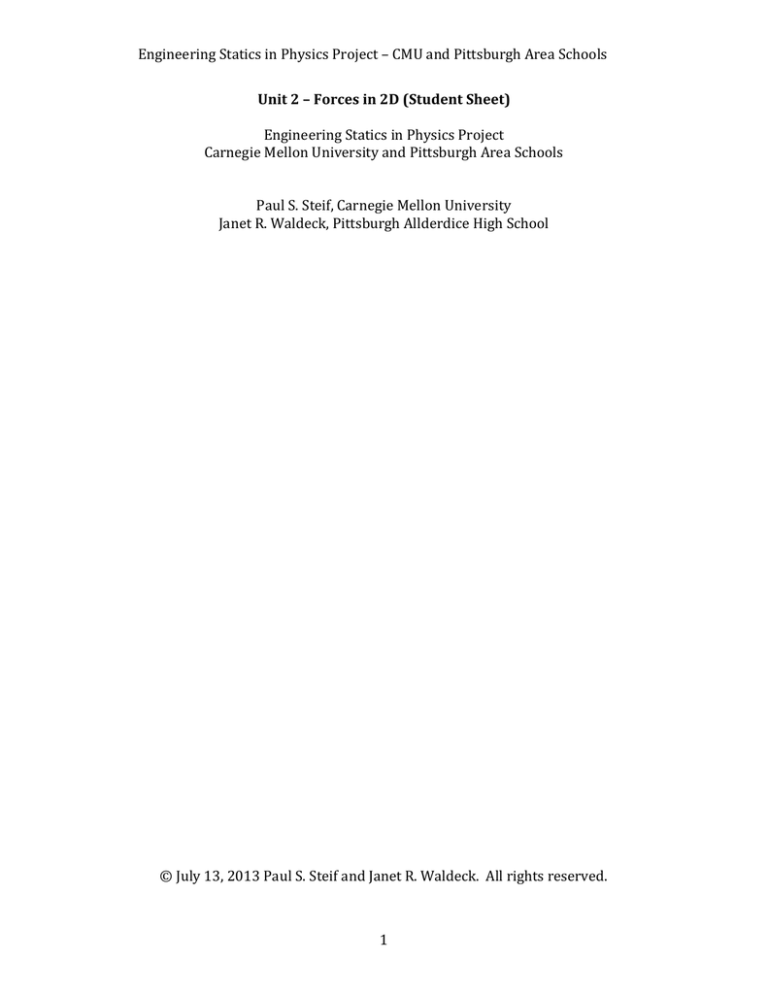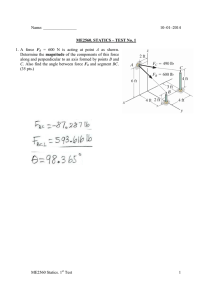
Engineering Statics in Physics Project – CMU and Pittsburgh Area Schools
Unit 2 – Forces in 2D (Student Sheet)
Engineering Statics in Physics Project
Carnegie Mellon University and Pittsburgh Area Schools
Paul S. Steif, Carnegie Mellon University
Janet R. Waldeck, Pittsburgh Allderdice High School
© July 13, 2013 Paul S. Steif and Janet R. Waldeck. All rights reserved.
1
Engineering Statics in Physics Project – CMU and Pittsburgh Area Schools
2.1 Forces can change the direction of motion
Carefully roll a bowling ball at a constant speed down the hallway. Apply a tap from
a mallet to get the ball to make a turn while in motion:
On the diagram above, draw an arrow to indicate the force (size and direction)
needed to make the bowling ball turn as shown
On the xy-axis shown below, draw an arrow to represent the force you used to
change the direction of the moving bowling ball. Place the tail of the arrow at the
origin and label “direction” in terms of the angle relative to the positive x-axis.
y
x
2
Engineering Statics in Physics Project – CMU and Pittsburgh Area Schools
2.2 Forces are vectors
(i) using opposing spring scales to maintain equilibrium
Hold a ring in position with four spring scales, with each scale flat on the table.
Align the scales with the horizontal and vertical lines drawn on the next page, with
the ring centered with respect to the origin. Try to pull with different forces on the
scales A and B. Record values in the table below for several different cases.
Compare the forces in scales A and C and in B and D. What is the conclusion?
D
D
C
A
B
Case
1
2
3
4
5
Scale A (N)
Scale B (N)
Conclusion:
3
Scale C (N)
Scale D (N)
Engineering Statics in Physics Project – CMU and Pittsburgh Area Schools
4
Engineering Statics in Physics Project – CMU and Pittsburgh Area Schools
(ii) using three spring scales to maintain equilibrium
Replace spring scales C and D with a single spring scale E. The person with scale E
should adjust the force and the angle, so the ring does not move.
E
A
B
Try these combinations of forces in scales A and B: A = 5 N, B = 5 N; A = 10 N, B = 5
N; A = 15 N, B = 5 N.. Hold the ring over the axis origin on the next page, scale A
along the (-)-horizontal axis and scale B along the (-)-vertical axis. Draw a labeled
line parallel to E for each of the three cases. Use that line to determine the angle of E
relative to the (+)-horizontal line. Record the force of scale E (Scale E Force) and
the angle of scale E (Scale E angle) relative to the (+)-horizontal axis in the table
below. The columns “Hypotenuse” and “Triangle angle” will be filled in later.
Triangle
5 by 5
10 by 5
15 by 5
Hypotenuse Scale E Force (N)
5
Triangle angle
Scale E angle
Engineering Statics in Physics Project – CMU and Pittsburgh Area Schools
6
Engineering Statics in Physics Project – CMU and Pittsburgh Area Schools
Draw three right triangles below, with the legs as listed:
Vert.
Leg
Horiz.
Leg
Drawing of Triangle
Horiz. Leg = 5 cm
Vert. Leg = 5 cm
Drawing of Triangle
Horiz. Leg = 10 cm
Vert. Leg = 5 cm
Drawing of Triangle
Horiz. Leg = 15 cm
Vert. Leg = 5 cm
For each triangle measure the length of the hypotenuse and the angle the
hypotenuse makes with respect to the horizontal axis. Enter these values into the
columns “Hypotenuse” and “Triangle angle” in the table above. In each of three
cases, compare what you found for the hypotenuse with what you found for the
force in scale E and its angle.
Scale E does what scales C and D together did. So how do forces combine?
7
Engineering Statics in Physics Project – CMU and Pittsburgh Area Schools
2.3 Balancing forces in two dimensions
In rock climbing, cords connected to anchors in the rock hold you up. The cords will
be oriented at different angles, which affect the forces. Clamps on oppositely facing
chemistry support stands can serve as the anchors to hold the spring scales. Place
books on the stand bases if they tend to slip or tip. Use S-hooks to connect the scales
to a central ring and to hang the block from the ring.
ring
θ
θ
Block
Record the combined weight of the block, S-hooks, and ring ___________
8
Engineering Statics in Physics Project – CMU and Pittsburgh Area Schools
(i) spring scales oriented symmetrically
Place the support stand clamps at the same height, and attach the scales to the
clamps and the ring, so that the scales make the same angle with respect to the
horizontal. Record the scale readings and the angle used for three different
configurations.
Left scale tension
Right scale tension
Angle θ with horizontal
How do the scale readings change, as the stands are placed farther apart?
On the xy-axis below, draw a vector starting at the origin to represent the scale
tension for each trial. The length of each vector should be proportional to the value
of tension recorded. And the vector should be positioned to represent accurately
the direction of the scale force (i.e. the correct angle). Draw a vector starting at the
origin representing the weight force.
9
Engineering Statics in Physics Project – CMU and Pittsburgh Area Schools
(ii) spring scales oriented unsymmetrically
Attach the clamps to the stand at different heights so that each scale makes its own
angle with respect to the horizontal axis (θL and θR). Make sure that they are
positioned so each scale stretches, but not to its maximum reading.
TL
ring
θL
TR
θR
Weight
Block
Repeat this multiple times, recording the angles and scale readings in the table
below.
Left tension TL
Left angle θL
Right tension TR
Right angle ΘR
Using the measurements, you will calculate the net force in x direction and the y
direction on the ring. We can use trigonometry to solve for the horizontal
component and vertical component of a force vector. For example,
D = F cos θ
F
C
C = F sin θ
θ
D
10
Engineering Statics in Physics Project – CMU and Pittsburgh Area Schools
Use these trig functions to resolve each scale force vector (recorded above) into
horizontal and vertical components. The scale tension corresponds to the
magnitude F, which is different for left and right scales.
For example:
TRx (right scale horizontal) = TR cos θR and TRy (right scale vertical) = TR sin θR
Enter the horizontal and vertical components due to each scale into the table.
Next, determine the total horizontal force and the total vertical force. Let x be
positive if to right, negative if to left. Let y be positive if up, negative if down.
Horizontal Components
TRx
TLx
TRv - TLx
Vertical Components
TRv
TLy
What trend(s) do you notice with the total horizontal force?
What trend(s) do you notice with the total vertical force?
11
W
TRv +TLv - W
Engineering Statics in Physics Project – CMU and Pittsburgh Area Schools
2.4 Forces experienced by a body on a ramp
(i) a spring scale opposes the component of gravity pulling a truck down the
ramp
Weigh a wooden toy truck. Weight of truck = __________N_
Place the truck on a level ramp and add a weight (about 1 kg) to the truck. Then,
raise one end of the ramp and use a spring scale, hooked onto the truck and held
parallel to the ramp, to keep the truck in place. With the ramp held at three
different angles (approximately 30, 45, 60) record the reading on the spring
scale.
Angle
Measured Spring Force
Parallel to Ramp
In order for the truck to remain in place, the force pulling the truck down the
inclined plane must be balanced by the upward pull of the spring scale. Here are all
the forces on the truck:
Fscale
W
Fscale
θ
FN
θ
The force FN does not affect balance of forces along the inclined plane. To better
understand how W and Fscale balance, we will use trigonometry to find the pull due
to gravity along the inclined plane.
W
Fscale
Fscale
θ
FN
W
12
θ
Engineering Statics in Physics Project – CMU and Pittsburgh Area Schools
Notice that when the ramp is on an angle θ, it appears to form a right-triangle with
one side along the table’s surface. By turning your head by θ, you can imagine the
new y-axis to be oriented perpendicular to the ramp’s surface and the force due to
the spring scale to then point along the (+)-horizontal axis. From consideration of
the angle θ, one can calculate the component of W along the (-)-horizontal axis:
│Fx│= W ∙ sinθ. To see if this component does indeed fulfill our expectation,
calculate it for each of the three angles recorded above and compare to the scale
readings.
Angle
W (= Truck + Added Weight)
W ∙ sinθ
13
Measured Spring Force
Parallel to Ramp
Engineering Statics in Physics Project – CMU and Pittsburgh Area Schools
(ii) force due to friction between a block and the incline surface will serve to
counter the component of gravity pulling the block down the ramp
Weigh a large block. The magnitude of the block’s weight is equal to the normal
force (N) on the block when it rests on a horizontal surface. Obtain three different
fabric samples: gray, flannel and brown.
Weight of large block = ___________
For each fabric, in turn, lay the fabric on a horizontal surface and place the block on
the fabric. Pull horizontally with a spring scale, recording the minimum force
needed to cause the block to slip. From this value, calculate the coefficient of static
friction (μs,max) for the block/fabric system.
Fabric
Gray – Trial 1
Gray – Trial 2
Gray – Trial 3
Flannel – Trial 1
Flannel – Trial 2
Flannel – Trial 3
Brown – Trial 1
Brown – Trial 2
Brown – Trial 3
Force to Initiate (Fs)
Normal Force = N
s,max = Fs /N
Fabric
Average s,max
Gray
Flannel
Brown
Next, place each of the cloths, in turn, on the board and place the large block on the
cloth. Tilt the board until the block starts to slip and record the angle of the board
where slipping first starts to occur.
Surface
Angle where slipping
begins to occur
Gray
Flannel
Brown
14
Engineering Statics in Physics Project – CMU and Pittsburgh Area Schools
Here are all the forces on the block:
W
W
Ffric
θ
FN
Ffric
θ
FN
Again, tilt your head by θ. The force of gravity has components along the inclined
plane and perpendicular to it.
W∙cosθ
θ
W
W∙sinθ
For the block to remain stationary, Ffric = W∙sinθ, and the normal force FN is balanced
by the component of W perpendicular to the ramp’s surface, FN = W∙cosθ.
When the inclined plane is gradually tilted, the block slips at an angle θs. This was
measured and depends on the fabric. The friction force has reached the maximum
value Ffric,max = μs ∙ FN . So μs = Ffric,max / FN = W∙sinθs / W∙cosθs = sinθs / cosθs. From
the measured angle θs, calculate the coefficient of static friction. Compare with the
measurements of μs from pulling the block along the fabric.
Fabric
θs (angle when slipping
begins to occur
μs = sinθs / cosθs
15
μs (pulling block
on fabric)




